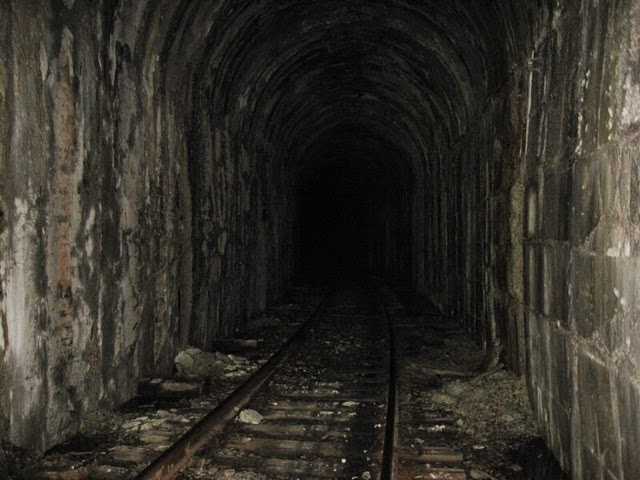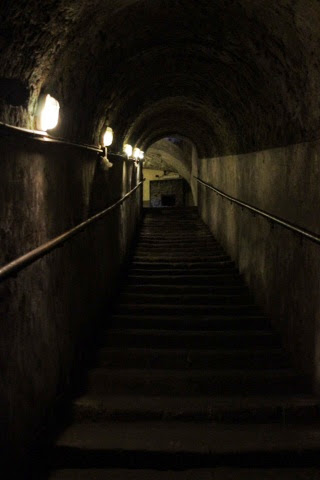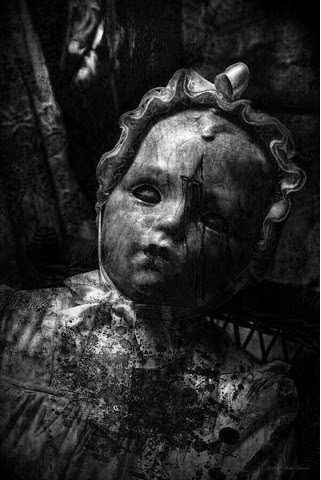Wednesday, July 30, 2014
Sunday, July 27, 2014
Dark Arts: Joshua Hoffine
 |
| "Keyhole" |
Joshua Hoffine, a fellow Midwesterner like myself, is a horror photographer who describes his photographs as “small movies”. They are packed with visual splendor, with no detail going unnoticed by the artist.
His work exists in the realm of childhood fears and nightmares, where innocence is threatened by boogeymen, witches, and psychos. They lurk in all the familiar places—the basement, the bathroom, and, oh yes, under the bed. An extra layer of intimacy is added to Hoffine’s artwork once you discover that nearly all of his sets are cleverly handcrafted and shot in his own home, and that his own daughters are often the subjects of his ghoulish visions.
He had been featured in countless newspapers and magazines and appears most recently in the latest issue of Fangoria discussing his latest project: Monster Prom. Thanks to a successful Kickstarter page, Hoffine will soon be completing his first short film entitled, “Black Lullaby”, which stars his daughter, Chloe, as a little girl who comes face to face with the boogeyman.
Below are just a few windows into his wonderfully unhinged worlds. You can view more at his website, here.
 |
| "Babysitter" |
 | ||
| "Basement" |
 |
| "Bedside" |
Wednesday, July 23, 2014
Friday, July 18, 2014
ROOTS OF HORROR: The Death Coach And Other Spectral Vehicles
Imagine you are driving alone late at night on a one-lane, backwoods road. Your headlights graze the trees that hug close to the road, the hum of your tires drones softly under music or talk radio. The monotony of the seemingly endless unraveling road sets your mind to daydream—but your thoughts are interrupted by the twin points of headlights in your rear-view mirror. The car must have just crested some hill, or rounded some turn, because this is the first time you’ve seen anyone else on the road tonight. The car is traveling at an alarming speed, and as they slow down to pull up beside you see it is a strange black car. The window begins to roll down…
If you are unfamiliar with any legends concerning sinister automobiles, then I am here to inform you. They come in several different forms, each one as unsettling as the last.
 The Death Coach
The Death Coach The Death Coach has its strongest roots in Ireland, where it is called the Cóiste Bodhar (koe-shta bower), which translates to “deaf coach” or “silent coach”. The Cóiste Bodhar is a death omen and to see it or hear it means that someone is going to die. The Irish version of the Death Coach is quite sinister looking and is often decorated with candles and human remains.
Even more frightening than the wagon itself is its driver, a fairy called a dullahan. His head, which is carried under one arm, has small, flicking black eyes and a wide, ear-to-ear grin. He carries a whip made from a human spine. If you hear the dullahan call out a name, it is sure that the owner is the next to die. While the Cóiste Bodhar can go through any locked gate, the dullahan is terrified of gold, and having any near will send them away. The Cóiste Bodhar makes an appearance in the 1959 Disney film (a childhood favorite of mine) Darby O’Gill and the Little People.
The revolutionary Swedish special effects film, The Phantom Carriage (1921), concerns a similar legend. In the film, the last person to die before the clock strikes twelve on New Years Eve must take the seat at the front of the Death Coach and collect souls of the dead for the next year.
In Robert W. Chamber’s iconic short story, “The Yellow Sign”, the Death Coach comes through an ominous dream, whose driver is a man with pale, puffy flesh, who reminds the narrator of a, “plump, white grave-worm.”
I, too, have taken inspiration from the legend of the Death Coach, and have written of it in my story, “Crossroad”, published in the 4th issue of Sanitarium Magazine.
The Hearse
“Don’t you ever laugh as the hearse goes by, for you may be the next to die,” sings “The Hearse Song” as documented in Scary Stories to Tell in the Dark. If hearses weren’t ominous enough for you, there are several superstitions attached to the corpse-carrying cars. For example, it is bad luck if a hearse stops in front of someone’s house, as it is a sign that an occupant will soon die; even the sight of a hearse is a possible omen, especially if it is empty, for it means that it is looking to be filled.
The song I aforementioned dates back to World War I, sung by American and British soldiers and popularized as a children’s rhyme. Also frequently called, “The Worms Crawl In, The Worms Crawl Out”, several different versions have been documented—below I’ve written the lyrics to just one.
“Don’t you ever laugh as the hearse goes by,
For you may be the next one to die.
They wrap you in a big white sheet
From your head down to your feet.
They put you in a big black box
And cover you up with dirt and rocks.
All goes well for about a week,
Until your coffin begins to leak.
The worms crawl in, the worms crawl out,
The worms play pinochle on your scalp,
They eat your eyes, they eat your nose,
They eat the jelly between your toes.
A big green worm with rolling eyes
Crawls in your stomach and out your sides.
Your stomach turns a slimy green,
And pus pours out like whipping cream.
You’ll spread it on a slice of bread,
And this is what you eat when you are dead.”
The Black Volga
One of my favorite urban legends is that of the Black Volga. This tale became popular in the 60’s in Eastern European; the car, a black Volga, is said to kidnap children and use them for gruesome black market trades. The car of legend has had a myriad of drivers such as nuns, vampires, or the very Devil. Sometimes the car will be driven by no one at all, startling those in the car alongside it so badly that they will swerve off the road.
Author Joe R. Lansdale penned a story called, “The Folding Man” for the urban legend-inspired anthology, Haunted Legends (you can read my review of the book, here.) His tale, inspired by the legend of the Black Volga, involves a group of teens being tormented on Halloween by a car full of nuns.
The doomful black car also plays a key role in the 2003 film, Dead End, in which a family takes a back road in an attempt of avoiding traffic and find themselves in an evil, haunted place where the only other car is the Black Volga, coming to claim its victims.
So the next time you are on that lonely stretch of road and see another pair of headlights, beware the Black Volga.
Labels:
death coach,
hearse,
Roots of Horror,
Spectral Vehicles
Wednesday, July 16, 2014
Saturday, July 12, 2014
The Uncertain Guest (El Habitante Incierto, 2004): Are You In The (Spanish) House Alone?
A while back, I saw a great Spanish thriller called Julia's Eyes (Los Ojos de Julia, 2010), directed by
Guillem Morales. I'm a big fan of foreign films - and of discovering a director's previous works after enjoying a movie they've just done. So it was only natural that I would eventually come to find The Uncertain Guest (a.k.a. The Uninvited Guest).
I bought the film (Amazon) sight unseen, which I have only done a handful of times. But I had read decent reviews (there and elsewhere) and took a chance. Glad I did, as it turned out to be a really decent, interesting little film.
Poor Felix (Andoni Gracia, looking more than a little like a more handsome Dudley Moore). Although a successful architect, his longtime girlfriend has just left him alone with a huge house and a broken heart. He strives to make the most of it, but he feels lonely and it's all he can do not to beg Vera (Mónica López) to come back to him. As she takes the rest of her things and goes, Felix settles into his sparsely decorated yet spiffy abode and does the usual. Feels bad for himself and wonders how he will ever live without her. When the doorbell rings, he rushes to answer it, thinking it's Vera coming back to him. Alas, it's a stranger, asking to use his phone. The man indicates that the pay phone nearby isn't working, and though most people wouldn't, Felix allows the stranger inside to use his telephone. [I do realize this is a movie, and people in movies always do stupid things or there would be no plot to speak of, but personally, I've seen waaaay too many horror movies to even remotely think of letting a stranger use my phone. But.......]
Felix shows the stranger to his phone and is rather taken aback when the man asks for privacy. Felix reluctantly leaves the room and waits patiently. When it seems to be taking a rather long time, Felix enters the kitchen only to discover the man is gone. Did he exit through the door? Why didn't Felix see him? Why didn't the stranger say thank you? Wait....did he leave at all?
Paranoia sets in. Felix begins to hear things. Noises that may or may not be the house settling or a cat in the alleyway. Quiet knocks and bumps in the night have Felix so on edge that he calls in the police (who of course cannot find a damn thing) and finally ends up sleeping curled up in the fetal position in his car in the garage, completely convinced that the stranger has never left and is squatting in his mansion...somewhere.
He ends up relaying these suspicions to Vera, who at first thinks he's crazy and then seems to feel some sort of pity that ends up with the two of them having ex-sex. As per the norm, this kind of quick bedtime romp never works out, and although Vera does feel some degree of love for Felix, they argue about whether or not someone is actually in the house and the fight doesn't end well. Felix is alone again, and soon even more certain someone is living in the house with him.
Thinking that this is where the plot is going is your first mistake. This movie drifts effectively off into two or maybe even three directions, which will keep you guessing. One night, when Felix thinks he has caught up to the stranger, he shoots him and locks him in a room. Searching out the man's identity, he ends up at house nearby inhabited by a woman in a wheelchair that he thinks may be the stranger's wife. Claudia is engaged in conversation with another man - her brother-in-law - about her hubby having gone missing.
And this is where the film does a total 180. Felix becomes strangely enamored with Claudia and can't help himself from actually entering her house and living there! For all intents and purposes, he is a squatter with a voyeuristic fascination with the resident female. There are unexpected comedic moments interspersed with pure creepiness as Felix follows Claudia around her home - it's quite easy for him to move around undetected as she is wheeling everywhere and he is always one step ahead of her.
The role reversal here is absolutely brilliant. I loved wondering if Felix was completely off his rocker or just a little bit sad. I still wondered throughout the film - was there actually anyone ever in Felix's house or is he really just that crazy? When we meet Felix he is a shattered man, brokenhearted and bereft of all happiness. He becomes increasingly paranoid, which is rather fun to watch - but then by the end you really wonder how this could possibly end well. Because let's not forget...... there is a wounded (or dead?) man in one of the upstairs bedrooms of his own house.
El Habitante Incierto is a great under-the-radar thriller that offers more than your average slash and trash horror flick. It has laudable performances by the lead actors and it's easy to become invested in Felix's life and problems. I've heard it compared to Hitchcock, and while I won't be that generous, it was full of beautiful cinematography and clever suspense. Naturally, being a Spanish film it is subtitled - but don't let that deter you or you'll miss some excellent cinematic journeys from around the world. And this one is a worthy trip.
I bought the film (Amazon) sight unseen, which I have only done a handful of times. But I had read decent reviews (there and elsewhere) and took a chance. Glad I did, as it turned out to be a really decent, interesting little film.
Poor Felix (Andoni Gracia, looking more than a little like a more handsome Dudley Moore). Although a successful architect, his longtime girlfriend has just left him alone with a huge house and a broken heart. He strives to make the most of it, but he feels lonely and it's all he can do not to beg Vera (Mónica López) to come back to him. As she takes the rest of her things and goes, Felix settles into his sparsely decorated yet spiffy abode and does the usual. Feels bad for himself and wonders how he will ever live without her. When the doorbell rings, he rushes to answer it, thinking it's Vera coming back to him. Alas, it's a stranger, asking to use his phone. The man indicates that the pay phone nearby isn't working, and though most people wouldn't, Felix allows the stranger inside to use his telephone. [I do realize this is a movie, and people in movies always do stupid things or there would be no plot to speak of, but personally, I've seen waaaay too many horror movies to even remotely think of letting a stranger use my phone. But.......]
Felix shows the stranger to his phone and is rather taken aback when the man asks for privacy. Felix reluctantly leaves the room and waits patiently. When it seems to be taking a rather long time, Felix enters the kitchen only to discover the man is gone. Did he exit through the door? Why didn't Felix see him? Why didn't the stranger say thank you? Wait....did he leave at all?
Paranoia sets in. Felix begins to hear things. Noises that may or may not be the house settling or a cat in the alleyway. Quiet knocks and bumps in the night have Felix so on edge that he calls in the police (who of course cannot find a damn thing) and finally ends up sleeping curled up in the fetal position in his car in the garage, completely convinced that the stranger has never left and is squatting in his mansion...somewhere.
He ends up relaying these suspicions to Vera, who at first thinks he's crazy and then seems to feel some sort of pity that ends up with the two of them having ex-sex. As per the norm, this kind of quick bedtime romp never works out, and although Vera does feel some degree of love for Felix, they argue about whether or not someone is actually in the house and the fight doesn't end well. Felix is alone again, and soon even more certain someone is living in the house with him.
Thinking that this is where the plot is going is your first mistake. This movie drifts effectively off into two or maybe even three directions, which will keep you guessing. One night, when Felix thinks he has caught up to the stranger, he shoots him and locks him in a room. Searching out the man's identity, he ends up at house nearby inhabited by a woman in a wheelchair that he thinks may be the stranger's wife. Claudia is engaged in conversation with another man - her brother-in-law - about her hubby having gone missing.
And this is where the film does a total 180. Felix becomes strangely enamored with Claudia and can't help himself from actually entering her house and living there! For all intents and purposes, he is a squatter with a voyeuristic fascination with the resident female. There are unexpected comedic moments interspersed with pure creepiness as Felix follows Claudia around her home - it's quite easy for him to move around undetected as she is wheeling everywhere and he is always one step ahead of her.
The role reversal here is absolutely brilliant. I loved wondering if Felix was completely off his rocker or just a little bit sad. I still wondered throughout the film - was there actually anyone ever in Felix's house or is he really just that crazy? When we meet Felix he is a shattered man, brokenhearted and bereft of all happiness. He becomes increasingly paranoid, which is rather fun to watch - but then by the end you really wonder how this could possibly end well. Because let's not forget...... there is a wounded (or dead?) man in one of the upstairs bedrooms of his own house.
El Habitante Incierto is a great under-the-radar thriller that offers more than your average slash and trash horror flick. It has laudable performances by the lead actors and it's easy to become invested in Felix's life and problems. I've heard it compared to Hitchcock, and while I won't be that generous, it was full of beautiful cinematography and clever suspense. Naturally, being a Spanish film it is subtitled - but don't let that deter you or you'll miss some excellent cinematic journeys from around the world. And this one is a worthy trip.
Friday, July 11, 2014
Fusions Of Fright: Tales From The Black Meadow
~by Marie Robinson
Welcome back for your monthly dose of Fusions of Fright, our column highlighting music and musicians with a taste for the macabre.
Today I present to you a highly original project, and because of it’s nature this article will become a sort of two-in-one—an album review and a book review. Tales from the Black Meadow comes in print and audio form, although not the way you might expect it.
The book, written by Chris Lambert, is a collection of stories and poems all in reference to a mysterious (fictitious) village in North Yorkshire called the Black Meadow. Although the place inexplicably vanished, left behind was a body of work by a Professor Roger Mullins, who had a great fascination with the village and its local superstitions. He spent years collecting the local legends and writing them down in notebooks, which thankfully were saved after he went missing in 1972. Tales from the Black Meadow is presented as being taken straight from these notebooks of folkloric research.
The CD consists of 12 musical tracks to accompany the tales, beginning with the “Main Theme”. To me, it easily sounds like the opening to a television show from the late 70's. I can see the title card and the credits appearing over gently revolving images—a moonlit meadow here, an old tree, the silhouettes of children playing. I’m certain that at the start of the show we would find a gentleman in front of a blazing fire in some English parlor, closing the dusty tome he was holding to welcome us to the show.
The album was written and performed by a UK band called The Soulless Party, whose EP Exploring Radio Space is also available on their bandcamp. Every track, with the exception of “The Man from the Ministry”, has an accompanying tale in the book. I heard about the music first, and upon enjoying the opening song, found the bandcamp for the record. It was there that I learned about the book behind the music and I fell in love with the idea. Even though I believe most (if not all) of the album was done on a keyboard, great effort was put in to establish atmosphere, and I believe it was accomplished. Even without the existence of the backing stories one could still listen to the record and have a sense of the supernatural and the uncanny; dark foggy nights can be heard in the muted tracks. Little details give the songs on Tales from the Black Meadow their spooky spice, such as the soft crackling on each track, giving it the feel of an old vinyl record. Many tracks are sprinkled with atmospheric sounds, like bird song, church bells, or the tramp of a horse's hooves.
 Tales
from the Black Meadow is streaming for free on the Soulless Party’s
bandcamp, here
(http://thesoullessparty.bandcamp.com/album/tales-from-the-black-meadow).
It is also available for purchase in digital form and in a 2-disc CD
that includes all 20 tracks on one disc and the Radio 4 Documentary:
“The Curse of the Black Meadow” on the other, not to mention a booklet
of photographs and a note from writer and artist Warren Ellis.
Tales
from the Black Meadow is streaming for free on the Soulless Party’s
bandcamp, here
(http://thesoullessparty.bandcamp.com/album/tales-from-the-black-meadow).
It is also available for purchase in digital form and in a 2-disc CD
that includes all 20 tracks on one disc and the Radio 4 Documentary:
“The Curse of the Black Meadow” on the other, not to mention a booklet
of photographs and a note from writer and artist Warren Ellis.
“The Curse of the Black Meadow” is a 20-minute mockumentary on the legends of the Black Meadow, including “interviews”, songs, and even more information on the spectral village. As well as being included in the 2-disc purchase of Tales from the Black Meadow it is sold separately on Amazon (right here).
The book reads like a book of scary stories to tell children
before bedtime. The writing is simple and purposefully repetitive, but
Lambert goes to great lengths to create the eerie world of the Black
Meadow. The book contains 25 tales and nearly as many illustrations. One
more dimension in the world of the Black Meadow exists in “The
Brightwater Archive”. As the story goes Lord Brightwater was the leading
scholar on The Black Meadow in the 30’s, and the blog is a collection
of his research findings. After reading the book, listening to the CD
and the Radio 4 Documentary I am so impressed and inspired by the
lengths Lambert went to to bring his mythos to life and spread it out
through so many mediums. It is always inspirational to see originality
and another’s appreciation for folklore. The Tales from the Black Meadow
collection of stories is available for purchase on Amazon, here .
And enjoy the “Main Theme” from Tales from the Black Meadow below!
Welcome back for your monthly dose of Fusions of Fright, our column highlighting music and musicians with a taste for the macabre.
Today I present to you a highly original project, and because of it’s nature this article will become a sort of two-in-one—an album review and a book review. Tales from the Black Meadow comes in print and audio form, although not the way you might expect it.
The book, written by Chris Lambert, is a collection of stories and poems all in reference to a mysterious (fictitious) village in North Yorkshire called the Black Meadow. Although the place inexplicably vanished, left behind was a body of work by a Professor Roger Mullins, who had a great fascination with the village and its local superstitions. He spent years collecting the local legends and writing them down in notebooks, which thankfully were saved after he went missing in 1972. Tales from the Black Meadow is presented as being taken straight from these notebooks of folkloric research.
The CD consists of 12 musical tracks to accompany the tales, beginning with the “Main Theme”. To me, it easily sounds like the opening to a television show from the late 70's. I can see the title card and the credits appearing over gently revolving images—a moonlit meadow here, an old tree, the silhouettes of children playing. I’m certain that at the start of the show we would find a gentleman in front of a blazing fire in some English parlor, closing the dusty tome he was holding to welcome us to the show.
The album was written and performed by a UK band called The Soulless Party, whose EP Exploring Radio Space is also available on their bandcamp. Every track, with the exception of “The Man from the Ministry”, has an accompanying tale in the book. I heard about the music first, and upon enjoying the opening song, found the bandcamp for the record. It was there that I learned about the book behind the music and I fell in love with the idea. Even though I believe most (if not all) of the album was done on a keyboard, great effort was put in to establish atmosphere, and I believe it was accomplished. Even without the existence of the backing stories one could still listen to the record and have a sense of the supernatural and the uncanny; dark foggy nights can be heard in the muted tracks. Little details give the songs on Tales from the Black Meadow their spooky spice, such as the soft crackling on each track, giving it the feel of an old vinyl record. Many tracks are sprinkled with atmospheric sounds, like bird song, church bells, or the tramp of a horse's hooves.
 Tales
from the Black Meadow is streaming for free on the Soulless Party’s
bandcamp, here
(http://thesoullessparty.bandcamp.com/album/tales-from-the-black-meadow).
It is also available for purchase in digital form and in a 2-disc CD
that includes all 20 tracks on one disc and the Radio 4 Documentary:
“The Curse of the Black Meadow” on the other, not to mention a booklet
of photographs and a note from writer and artist Warren Ellis.
Tales
from the Black Meadow is streaming for free on the Soulless Party’s
bandcamp, here
(http://thesoullessparty.bandcamp.com/album/tales-from-the-black-meadow).
It is also available for purchase in digital form and in a 2-disc CD
that includes all 20 tracks on one disc and the Radio 4 Documentary:
“The Curse of the Black Meadow” on the other, not to mention a booklet
of photographs and a note from writer and artist Warren Ellis.“The Curse of the Black Meadow” is a 20-minute mockumentary on the legends of the Black Meadow, including “interviews”, songs, and even more information on the spectral village. As well as being included in the 2-disc purchase of Tales from the Black Meadow it is sold separately on Amazon (right here).
 |
| "The old woman stood outside, behind the gate, looking at the house" |
And enjoy the “Main Theme” from Tales from the Black Meadow below!
Subscribe to:
Posts (Atom)














































